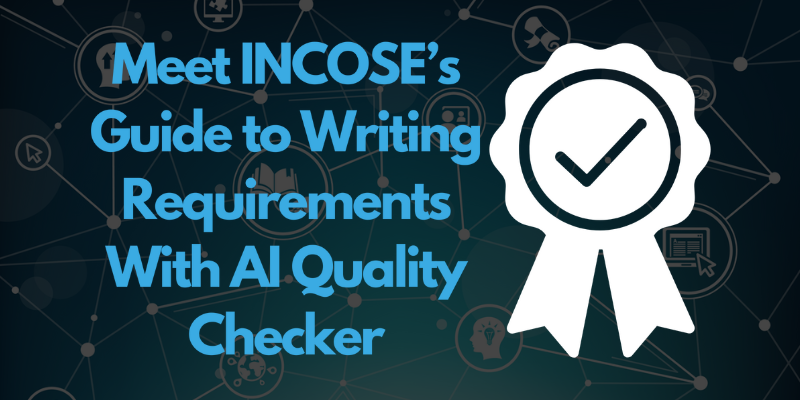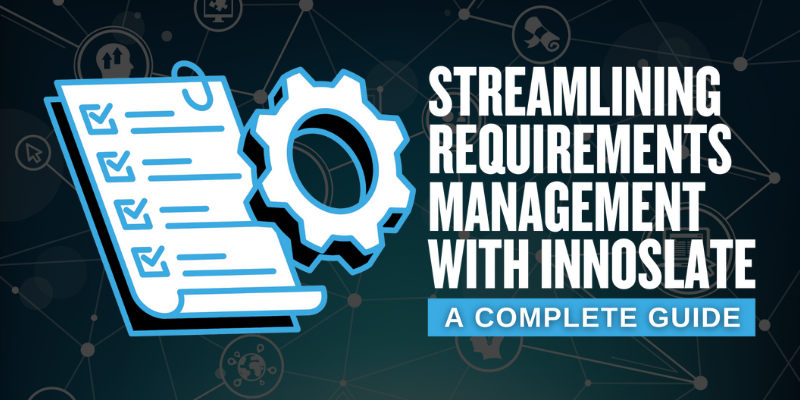How to Ensure Requirements Are Clear and Unambiguous
In the field of systems engineering and requirements management, clear and effective communication is crucial. The INCOSE Writing Guide, developed by...
2 min read
.jpg) Amir Abrari
:
9/20/24 10:51 AM
Amir Abrari
:
9/20/24 10:51 AM

Don't feel like reading? Watch the webinar recording instead!
In systems engineering and project management, the importance of clear and precise requirements cannot be overstated. The INCOSE (International Council on Systems Engineering) Requirements Working Group has been at the forefront of establishing standards that guide engineers in crafting effective requirements.
With the creation of technology, particularly artificial intelligence, the process of writing and validating these requirements has become more efficient and reliable. This blog explores Innoslate's AI Quality Checker and its design to help engineers meet INCOSE's standards seamlessly.
Established in 1992, the INCOSE Requirements Working Group aims to advance the practice of requirements management. Their latest version of the Requirements Writing Guide, released in July 2023, introduces a comprehensive set of rules and guidelines that engineers can follow to ensure their requirements are clear, unambiguous, and actionable. These standards are crucial for minimizing misunderstandings and ensuring that all stakeholders have a shared understanding of project goals.
The guide outlines various rules - up to 30 or 40 - that help engineers articulate their requirements effectively. These rules cover aspects such as clarity, necessity, feasibility, and verifiability, ensuring that every requirement serves its intended purpose.
As the complexity of projects increases, so does the challenge of maintaining high-quality requirements. This is where Innoslate's AI Quality Checker comes into play. By leveraging natural language processing and advanced algorithms, the Quality Checker assesses each requirement against INCOSE's standards, providing engineers with immediate feedback on their writing.
Automated Quality Assessment: The Quality Checker evaluates requirements in real-time, assigning a quality score based on predefined criteria. This allows engineers to identify potential issues early in the writing process.
Clear Feedback Mechanism: The tool highlights ambiguous terms or phrases and suggests alternatives or modifications. Engineers can toggle options to see how changes impact their quality score, fostering a culture of continuous improvement.
Traceability and Verification: The Quality Checker ensures that each requirement is traceable and verifiable. It provides indicators for "satisfied by" and "verified by" relationships, which are essential for maintaining the integrity of the requirements throughout the project lifecycle.
Customizable Views: Users can customize their document views to display relevant attributes, making it easier to focus on specific aspects of their requirements. This flexibility enhances the user experience and allows for tailored workflows.
Comprehensive Reporting: The AI Quality Checker can generate detailed reports on quality scores and requirements status, which can be shared with stakeholders. This transparency is vital for project management and ensures that everyone is aligned on the project's objectives.
One of the most significant advantages of using the Quality Checker is its ability to facilitate continuous improvement. Engineers can iteratively refine their requirements based on the feedback provided by the tool. By addressing issues such as duplicates or vague language, they can enhance the overall quality of their documentation.
Moreover, the Quality Checker encourages engineers to take ownership of their writing. While AI provides valuable assistance, it is essential for engineers to apply their judgment and expertise to ensure that the requirements align with project goals and stakeholder expectations.
As the engineering field continues to embrace technological advancements, tools like the Innoslate Quality Checker are becoming indispensable. By aligning with INCOSE's standards for writing requirements, engineers can produce high-quality documentation that drives project success. The combination of human expertise and AI capabilities creates a powerful synergy that enhances the requirements engineering process.
📘Keep Learning: Why Quality Assurance Matters in the Requirements Management Phase
Have questions about model-based systems engineering or requirements management? Talk to an expert and see how Innoslate can streamline your projects from start to finish.

In the field of systems engineering and requirements management, clear and effective communication is crucial. The INCOSE Writing Guide, developed by...
.png)
Want to sit back, relax, and listen? Watch the webinar recording!

2 min read
Don't feel like reading? Watch the webinar recording. Effective requirements management is crucial for the success of any project. As...